Multiple genres and formats in children’s and young adult literature enrich content area reading in science and social studies, providing multiple perspectives, exciting explorations of different topics, and examples of the work and thinking of scientists and historians. This collection includes nonfiction, fiction, and exemplars of content area reading formatted as poetry. All titles are sources for reading pleasure as well as developing deeper knowledge of content.
Ages 4–8
Frogs. Seymour Simon. 2015. Harper/HarperCollins.
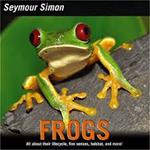 In this latest book in his series of science photo essays, Simon introduces readers to the world of frogs. A conversational text presents the life cycle, behavior, habitats, adaptations, and diversity of frogs. The language is clear; words that can be understood in context but are also defined in a glossary are in bold print. Simon includes a section on the different groups of amphibians and a six-page gallery of common frogs found in temperate regions (leopard fogs, bullfrogs, and wood frogs); unusual frogs from around the world (Darwin frogs, poison dart frogs, and Amazon horned frogs); and interesting toads from around the world (American toads, midwife toads, and fire-bellied toads). He also covers the role frogs play in the balance of nature and the problems responsible for the decline of frog populations around the world, including the chytrid fungus, which is now found in one third of the world’s frog population.
In this latest book in his series of science photo essays, Simon introduces readers to the world of frogs. A conversational text presents the life cycle, behavior, habitats, adaptations, and diversity of frogs. The language is clear; words that can be understood in context but are also defined in a glossary are in bold print. Simon includes a section on the different groups of amphibians and a six-page gallery of common frogs found in temperate regions (leopard fogs, bullfrogs, and wood frogs); unusual frogs from around the world (Darwin frogs, poison dart frogs, and Amazon horned frogs); and interesting toads from around the world (American toads, midwife toads, and fire-bellied toads). He also covers the role frogs play in the balance of nature and the problems responsible for the decline of frog populations around the world, including the chytrid fungus, which is now found in one third of the world’s frog population.
—CA
Grandaddy’s Turn: A Journey to the Ballot Box. Michael S. Bandy & Eric Stein.Ill. James E. Ransome. 2015. Candlewick.
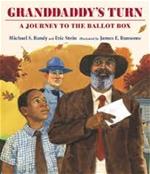 Written from the perspective of a man recounting his childhood and his experiences with his grandfather in the deep south of the United States, this historical fiction picture book gives a personal view of the tactics of the 1950s and 1960s in denying people their civil rights. The narrator emphasizes his grandfather’s dream of voting in the context of his grandfather’s resourcefulness and fortitude in his daily life. “My granddaddy was a big, strong man who always said he ‘never took nothing off nobody’. He could do anything” (unpaged). The illustrations show the child as a man going to the polls with the photograph of his grandfather to honor his aspirations long after the passage of the Civil Rights Act of 1965. The poignancy of the story is enhanced by the warm, earth tones of the watercolor illustrations, as readers experience the lives of the grandfather and the child. The author’s note in the back matter further explains practices that allowed public officials to keep people from voting.
Written from the perspective of a man recounting his childhood and his experiences with his grandfather in the deep south of the United States, this historical fiction picture book gives a personal view of the tactics of the 1950s and 1960s in denying people their civil rights. The narrator emphasizes his grandfather’s dream of voting in the context of his grandfather’s resourcefulness and fortitude in his daily life. “My granddaddy was a big, strong man who always said he ‘never took nothing off nobody’. He could do anything” (unpaged). The illustrations show the child as a man going to the polls with the photograph of his grandfather to honor his aspirations long after the passage of the Civil Rights Act of 1965. The poignancy of the story is enhanced by the warm, earth tones of the watercolor illustrations, as readers experience the lives of the grandfather and the child. The author’s note in the back matter further explains practices that allowed public officials to keep people from voting.
—SW
Leaflets Three, Let It Be! The Story of Poison Ivy. Anita Sanchez. Ill. Robin Brickman. 2015. Boyds Mills.
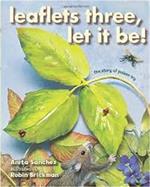 Readers who may know about poison ivy only from the itchy rash it has given them will find this story of poison ivy informative. While describing the appearance of the plant during the seasons of the year, Sanchez provides examples of how poison ivy gives food and shelter to wildlife. An inset highlighted in green print identifies the “poison” of poison ivy as urushiol,a chemical in itssap; another inset is a key to identifying the plant. Sayings about poison ivy appear in red: “Hairy vine—a warning sign! Leaflets three, let it be! Berries white, take flight!” An “Itching to Know More?” section provides answers to questions kids are likely to have about poison ivy and a quiz on distinguishing poison ivy from look-alike plants. Brickman adds a note on how she created the three-dimensional artwork.
Readers who may know about poison ivy only from the itchy rash it has given them will find this story of poison ivy informative. While describing the appearance of the plant during the seasons of the year, Sanchez provides examples of how poison ivy gives food and shelter to wildlife. An inset highlighted in green print identifies the “poison” of poison ivy as urushiol,a chemical in itssap; another inset is a key to identifying the plant. Sayings about poison ivy appear in red: “Hairy vine—a warning sign! Leaflets three, let it be! Berries white, take flight!” An “Itching to Know More?” section provides answers to questions kids are likely to have about poison ivy and a quiz on distinguishing poison ivy from look-alike plants. Brickman adds a note on how she created the three-dimensional artwork.
—CA
Mesmerized: How Ben Franklin Solved a Mystery That Baffled All of France. Mara Rockliff. Ill. Iacopo Bruno. 2015. Candlewick.
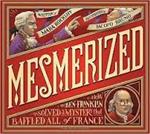 In a style that is both humorous and informative, Rockliff provides a context for Franklin’s journey to France during the American Revolution at the time of a surge in interest in science. Rockliff describes Dr. Mesmer’s attraction with his demonstration of a mysterious force, which he said “streamed from the stars and flowed into his wand” (p. 13). When asked to look into how the wand worked, Franklin used the scientific method, asking “What if the force was not in Dr. Mesmer’s wand?” (p. 21). Rockliff lays out the experiment that Franklin conducted. Illustrations in two-page spreads show each part of the experiment, and the narrative and sidebar provide comment on the method. Rockliff explains implications of the method: “Ben’s ‘blind’ test was such a good idea that it is still in use” (p. 36), and Dr. Mesmer had discovered the placebo effect. The back matter includes an author’s note describing scientific work going on in France at the end of the 18th century and information on how readers can use the scientific method.
In a style that is both humorous and informative, Rockliff provides a context for Franklin’s journey to France during the American Revolution at the time of a surge in interest in science. Rockliff describes Dr. Mesmer’s attraction with his demonstration of a mysterious force, which he said “streamed from the stars and flowed into his wand” (p. 13). When asked to look into how the wand worked, Franklin used the scientific method, asking “What if the force was not in Dr. Mesmer’s wand?” (p. 21). Rockliff lays out the experiment that Franklin conducted. Illustrations in two-page spreads show each part of the experiment, and the narrative and sidebar provide comment on the method. Rockliff explains implications of the method: “Ben’s ‘blind’ test was such a good idea that it is still in use” (p. 36), and Dr. Mesmer had discovered the placebo effect. The back matter includes an author’s note describing scientific work going on in France at the end of the 18th century and information on how readers can use the scientific method.
—SW
Ages 9–11
Big Red Kangaroo. Claire Saxby. Ill. Graham Byrne. 2015. Candlewick.
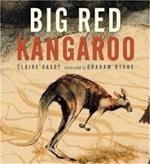 A lyrical text and stunning illustrations created with charcoal and digital media tell the story of Red Kangaroo, a dominant male, and the important role he plays in the lives of his mob of females, joeys, and younger male kangaroos in the hot, dry inland of Australia. Additional facts about red kangaroos and their adaptations for survival in their harsh environment appear in a different font on each two-page spread. An endnote provides general information on the diversity of kangaroos, marsupials that are adapted for living in a wide range of habitats from wet rainforests to dry plains in Australia and Papua New Guinea. The red kangaroo is the biggest of the more than 60 species of kangaroos. A Classroom Ideas PDF for Big Red Kangaroo is available from the Australian publisher.
A lyrical text and stunning illustrations created with charcoal and digital media tell the story of Red Kangaroo, a dominant male, and the important role he plays in the lives of his mob of females, joeys, and younger male kangaroos in the hot, dry inland of Australia. Additional facts about red kangaroos and their adaptations for survival in their harsh environment appear in a different font on each two-page spread. An endnote provides general information on the diversity of kangaroos, marsupials that are adapted for living in a wide range of habitats from wet rainforests to dry plains in Australia and Papua New Guinea. The red kangaroo is the biggest of the more than 60 species of kangaroos. A Classroom Ideas PDF for Big Red Kangaroo is available from the Australian publisher.
—CA
Emu. Claire Saxby. Ill. Graham Byrne. 2015. Candlewick.
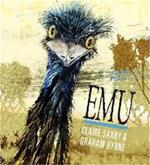 This narrative nonfiction book about emus, flightless birds of Australia, begins with “In the open forest, where eucalyptus trees fringe tufty grasslands, honey-pale sunshine seeps to where Emu sits on a nest” (p. 6). What readers may find surprising is that Emu, the adult sitting on the nest, is male. Following an extended mating ritual, the male and female build a nest. After laying eggs, the female departs. The male remains on the nest for eight weeks, tends the hatchlings, protects them from predators such as dingoes and eagles, and teaches them survival skills. After a year and a half, the young emus leave to find mates. Byrne’s exquisite digital artwork feature Emu and his brood in their grassland habitat. A Classroom Ideas PDF for Emu is available from the Australian publisher.
This narrative nonfiction book about emus, flightless birds of Australia, begins with “In the open forest, where eucalyptus trees fringe tufty grasslands, honey-pale sunshine seeps to where Emu sits on a nest” (p. 6). What readers may find surprising is that Emu, the adult sitting on the nest, is male. Following an extended mating ritual, the male and female build a nest. After laying eggs, the female departs. The male remains on the nest for eight weeks, tends the hatchlings, protects them from predators such as dingoes and eagles, and teaches them survival skills. After a year and a half, the young emus leave to find mates. Byrne’s exquisite digital artwork feature Emu and his brood in their grassland habitat. A Classroom Ideas PDF for Emu is available from the Australian publisher.
—CA
The Founding Fathers! Those Horse-Ridin’, Fiddle-Playin’, Book-Readin’, Gun-Totin’ Gentlemen Who Started America. Jonah Winter. Ill. Barry Blitt. 2015. Atheneum.
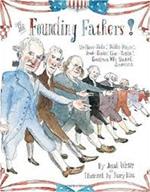 In his introduction, Winter establishes a historical context of the founding fathers he presents, arguing that the United States of the late 18th century was much different from what we know it to be now. Without a government, without political parties, the men who established the Constitution had to create a foundation and, although they argued constantly, they were “tremendously smart people” (unpaged). Two-page spreads follow, all formatted the same way with an illustration of the individual on one page and a brief biography, famous quotes of the person, and a table of information on diverse topics such as physical characteristics, jobs held, education, number of slaves owned, and political position on the facing page. Although some items are humorous, such as amount of cheese owned, the tables offer readers different ways of learning about the men. The extensive back matter deals with topics about which the fathers argued and could never agree. A connecting book, Founding Mothers: Remembering the LadiesbyCokie Roberts (2014), features biographies of the wives and relatives of some of the men in Winter’s book and introduces other women of the era.
In his introduction, Winter establishes a historical context of the founding fathers he presents, arguing that the United States of the late 18th century was much different from what we know it to be now. Without a government, without political parties, the men who established the Constitution had to create a foundation and, although they argued constantly, they were “tremendously smart people” (unpaged). Two-page spreads follow, all formatted the same way with an illustration of the individual on one page and a brief biography, famous quotes of the person, and a table of information on diverse topics such as physical characteristics, jobs held, education, number of slaves owned, and political position on the facing page. Although some items are humorous, such as amount of cheese owned, the tables offer readers different ways of learning about the men. The extensive back matter deals with topics about which the fathers argued and could never agree. A connecting book, Founding Mothers: Remembering the LadiesbyCokie Roberts (2014), features biographies of the wives and relatives of some of the men in Winter’s book and introduces other women of the era.
—SW
Midnight: A True Story of Loyalty in World War I. Mark Greenwood. Ill. Frané Lessac. 2015. Candlewick.
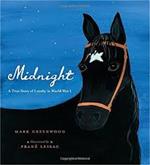 In 1914, Guy and his horse, Midnight, join the cavalry and sail from Australia to Egypt. Guy is sent to the front lines in Gallipoli; Midnight remains in Cairo. Once reunited, Guy and Midnight patrol the dunes of Sinai. In the charge at Beersheba, a bullet passes through Midnight and lodges beside Guy’s spine. The final two-page spread shows Guy waiting for the stretcher-bearers, crying beside the body of his beloved mare. Lessac’s naïve illustrations in saturated colors set the scene and clearly express the bond between Guy and Midnight. Greenwood and Lessac’s (2008) The Donkey of Gallipoli: A True Story of Courage in World War I tells how Jack Simpson carried more than 300 wounded men off the battlefield on a donkey
In 1914, Guy and his horse, Midnight, join the cavalry and sail from Australia to Egypt. Guy is sent to the front lines in Gallipoli; Midnight remains in Cairo. Once reunited, Guy and Midnight patrol the dunes of Sinai. In the charge at Beersheba, a bullet passes through Midnight and lodges beside Guy’s spine. The final two-page spread shows Guy waiting for the stretcher-bearers, crying beside the body of his beloved mare. Lessac’s naïve illustrations in saturated colors set the scene and clearly express the bond between Guy and Midnight. Greenwood and Lessac’s (2008) The Donkey of Gallipoli: A True Story of Courage in World War I tells how Jack Simpson carried more than 300 wounded men off the battlefield on a donkey
—CA
Ages 12–14
Anastasia and Her Sisters. Carolyn Meyer. 2015. Paula Wiseman.
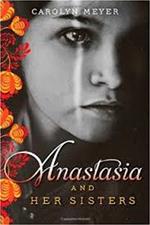 Anastasia Romanov, the youngest daughter of Tsar Nicholas II and Empress Alexandra, tells the story of her family’s life of public responsibility, regal privilege, and splendid wealth. She begins her narrative in the spring of 1918 when the family has been reunited in their exile (and shortly before their deaths). While she and her oldest sister, Olga, reminisce, Anastasia slips into her own memories as she describes a state ball of 1911. Through her narrative, she shares personal and public events in the lives of the family, and readers discover the maturing of the four sisters from pampered and protected girls to women who experience heartbreak, loss, and the realization that they could, and wanted to, do much more in their lives than their parents wanted for them. A genealogy at the beginning of the novel is a useful resource for readers, and an epilogue describes what happened to friends and relatives of the family. The Family Romanov: Murder, Rebellion, and the Fall of Imperial Russia by Candace Fleming (2014) is a connecting nonfiction book, richly illustrated with archival photographs, that details the historical events and places that figure in the novel.
Anastasia Romanov, the youngest daughter of Tsar Nicholas II and Empress Alexandra, tells the story of her family’s life of public responsibility, regal privilege, and splendid wealth. She begins her narrative in the spring of 1918 when the family has been reunited in their exile (and shortly before their deaths). While she and her oldest sister, Olga, reminisce, Anastasia slips into her own memories as she describes a state ball of 1911. Through her narrative, she shares personal and public events in the lives of the family, and readers discover the maturing of the four sisters from pampered and protected girls to women who experience heartbreak, loss, and the realization that they could, and wanted to, do much more in their lives than their parents wanted for them. A genealogy at the beginning of the novel is a useful resource for readers, and an epilogue describes what happened to friends and relatives of the family. The Family Romanov: Murder, Rebellion, and the Fall of Imperial Russia by Candace Fleming (2014) is a connecting nonfiction book, richly illustrated with archival photographs, that details the historical events and places that figure in the novel.
—SW
Call of the Osprey (Scientists in the Field Series).Dorothy Hinshaw Patent. Ill. William Muñoz. 2015. Houghton Mifflin Harcourt.
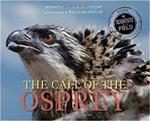 An engaging text and full-color, captioned photographs introduce readers to the osprey, a relative of hawks and eagles known as “the great fisher” because of its adaptation for catching fish, and document the work of three scientists at the Montana Osprey Project. The research project involves the monitoring of pairs of nesting ospreys to study the effect of the toxic metals that accumulated in the environment during extensive mining in the Missoula area. At the top of the food chain, the osprey is particularly susceptible to environmental pollution, making it an ideal indicator of progress being made in this Montana Superfund site. An abundance of sidebars offers information related to the project, including osprey statistics; the use of webcams that provide the opportunity for day-to-day observation of osprey behavior, mining, and the environment; and the establishments of the Superfund program in 1980.
An engaging text and full-color, captioned photographs introduce readers to the osprey, a relative of hawks and eagles known as “the great fisher” because of its adaptation for catching fish, and document the work of three scientists at the Montana Osprey Project. The research project involves the monitoring of pairs of nesting ospreys to study the effect of the toxic metals that accumulated in the environment during extensive mining in the Missoula area. At the top of the food chain, the osprey is particularly susceptible to environmental pollution, making it an ideal indicator of progress being made in this Montana Superfund site. An abundance of sidebars offers information related to the project, including osprey statistics; the use of webcams that provide the opportunity for day-to-day observation of osprey behavior, mining, and the environment; and the establishments of the Superfund program in 1980.
—CA
Voice of Freedom: Fannie Lou Hamer: Spirit of the Civil Rights Movement.Carole Boston Weatherford. Ill. Ekua Holmes. 2015. Candlewick.
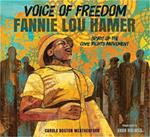 In a series of poems in this biography, Weatherford traces the life of Fannie Lou Hamer from her childhood as the youngest of 20 children of sharecroppers in Mississippi to her social and political activism. Weatherford chronicles the Civil Rights movement of the 1960s through Fannie Lou’s participation in voter registration, her involvement in the Student Nonviolent Coordinating Committee, her activity in party politics, and her running for elected office. The poems feature particular events in Hamer’s life and their implications, which provide readers with memorable, heart-wrenching details. In 1963, on a bus trip returning from citizenship school, for example, she and others ordered breakfast during a rest stop. Jailed for the act, the effects of the beatings she got there affected her for the rest of her life. To create a historical context, Weatherford provides an extensive timeline in the back matter, including events that occurred in the United States during the landmark moments Weatherford notes. The back matter also includes source notes and a list of resources.
In a series of poems in this biography, Weatherford traces the life of Fannie Lou Hamer from her childhood as the youngest of 20 children of sharecroppers in Mississippi to her social and political activism. Weatherford chronicles the Civil Rights movement of the 1960s through Fannie Lou’s participation in voter registration, her involvement in the Student Nonviolent Coordinating Committee, her activity in party politics, and her running for elected office. The poems feature particular events in Hamer’s life and their implications, which provide readers with memorable, heart-wrenching details. In 1963, on a bus trip returning from citizenship school, for example, she and others ordered breakfast during a rest stop. Jailed for the act, the effects of the beatings she got there affected her for the rest of her life. To create a historical context, Weatherford provides an extensive timeline in the back matter, including events that occurred in the United States during the landmark moments Weatherford notes. The back matter also includes source notes and a list of resources.
—SW
Ages 15+
Between Two Worlds. Katherine Kirkpatrick. 2014. Wendy Lamb.
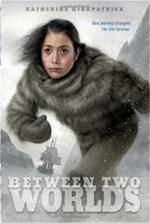 Billy Bah, a 16-year-old girl and wife of Angulluk, narrates the story of an expedition to the Arctic to get supplies to Admiral Peary. Billy Bah has been attached to the Peary family since she lived with them as a child in Brooklyn when Admiral and Josephine Peary’s daughter, Marie, was young. Billy Bah’s parents had come to New York City later and died there, under circumstances that are not clear to her until she can piece together details she learns and, in the process, come to a deeper understanding of the explorers’ influences on her people and culture. She recounts the many services her people provide the explorers and the shipmates who support them, their skills in hunting and sewing, family traditions and values, and practices in traveling over frozen sea and rough terrain the demanding environment of the Arctic of northern Greenland and Ellesmere Island required. The Snow Baby: The Arctic Childhood of Admiral Robert E. Peary’s Daring Daughter, also by Katherine Kirkpatrick (2007), is a connecting book full of archival photographs of individuals included in the novel, as well as Peary’s expeditions and family. The book Onward: A Photobiography of African-American Polar Explorer Matthew Henson by Delores Johnson (2006) focuses on the indispensable services that Henson gives to Peary’s work.
Billy Bah, a 16-year-old girl and wife of Angulluk, narrates the story of an expedition to the Arctic to get supplies to Admiral Peary. Billy Bah has been attached to the Peary family since she lived with them as a child in Brooklyn when Admiral and Josephine Peary’s daughter, Marie, was young. Billy Bah’s parents had come to New York City later and died there, under circumstances that are not clear to her until she can piece together details she learns and, in the process, come to a deeper understanding of the explorers’ influences on her people and culture. She recounts the many services her people provide the explorers and the shipmates who support them, their skills in hunting and sewing, family traditions and values, and practices in traveling over frozen sea and rough terrain the demanding environment of the Arctic of northern Greenland and Ellesmere Island required. The Snow Baby: The Arctic Childhood of Admiral Robert E. Peary’s Daring Daughter, also by Katherine Kirkpatrick (2007), is a connecting book full of archival photographs of individuals included in the novel, as well as Peary’s expeditions and family. The book Onward: A Photobiography of African-American Polar Explorer Matthew Henson by Delores Johnson (2006) focuses on the indispensable services that Henson gives to Peary’s work.
—SW
The Octopus Scientists (Scientists in the Field Series). Sy Montgomery. Ill. Keith Ellenbogen. 2015. Houghton Mifflin Harcourt.
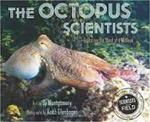 Montgomery and Ellenbogen join a team of researchers on the island of Moorea near Tahiti to document their study of the behavior of the Pacific day octopus. Details of their research is covered, from work in the field searching coral reefs for this elusive octopus (a master of camouflage and shape changing), locating the dens of individuals, and observing the octopuses, to lab work back at the field station identifying what the octopuses have eaten from the shells, carapaces, and remains of invertebrates found piled up outside dens. Full-color, captioned photographs and sidebars, including an interest-catching “octect of octo facts,” profiles of the octopus team, and a feature on coral reefs, extend the text. The Soul of an Octopus: A Surprising Exploration Into the World of Consciousness by Sy Montgomery (2015) documents her bonding experiences with octopuses as she pursued interest in how they use their minds to solve problems and develop individual personalities.
Montgomery and Ellenbogen join a team of researchers on the island of Moorea near Tahiti to document their study of the behavior of the Pacific day octopus. Details of their research is covered, from work in the field searching coral reefs for this elusive octopus (a master of camouflage and shape changing), locating the dens of individuals, and observing the octopuses, to lab work back at the field station identifying what the octopuses have eaten from the shells, carapaces, and remains of invertebrates found piled up outside dens. Full-color, captioned photographs and sidebars, including an interest-catching “octect of octo facts,” profiles of the octopus team, and a feature on coral reefs, extend the text. The Soul of an Octopus: A Surprising Exploration Into the World of Consciousness by Sy Montgomery (2015) documents her bonding experiences with octopuses as she pursued interest in how they use their minds to solve problems and develop individual personalities.
—SW
The World Within: A Novel of Emily Brontë. Jane Eagland. 2015. Scholastic.
 In this richly detailed novel, one period in Emily’s life is the focus, a time when her elder sister, Charlotte, goes away to school and their childhood camaraderie is transformed. When Charlotte returns from school, Emily feels a distance that she cannot bridge, and she draws closer to her younger sister, Anne, in their exploration of literature and in the worlds they create in stories they write. The introspective and introverted Emily is challenged to understand the perspectives and goals of her contemporaries and siblings. Later, going to the same school that Charlotte attended causes Emily such physical distress she is brought home ill, and her journey into who she wants to be and what she wants to do in her life begins in earnest. In the process, she discovers her strengths and comes to understand the uniqueness of her siblings. The Brontë Sisters: The Brief Lives of Charlotte, Emily, and Anne by Catherine Reef (2012) is a connecting book that chronicles the home and work life of the Brontë sisters, their brother, Branwell, and individuals featured in the novel such as Mary Taylor, a lifelong friend of Charlotte.
In this richly detailed novel, one period in Emily’s life is the focus, a time when her elder sister, Charlotte, goes away to school and their childhood camaraderie is transformed. When Charlotte returns from school, Emily feels a distance that she cannot bridge, and she draws closer to her younger sister, Anne, in their exploration of literature and in the worlds they create in stories they write. The introspective and introverted Emily is challenged to understand the perspectives and goals of her contemporaries and siblings. Later, going to the same school that Charlotte attended causes Emily such physical distress she is brought home ill, and her journey into who she wants to be and what she wants to do in her life begins in earnest. In the process, she discovers her strengths and comes to understand the uniqueness of her siblings. The Brontë Sisters: The Brief Lives of Charlotte, Emily, and Anne by Catherine Reef (2012) is a connecting book that chronicles the home and work life of the Brontë sisters, their brother, Branwell, and individuals featured in the novel such as Mary Taylor, a lifelong friend of Charlotte.
—SW
Sandip Wilson serves as associate professor at in the College of Health and Education of Husson University in Bangor, ME. Carolyn Angus is former Director of George G. Stone Center for Children's Books, Claremont Graduate University, CA.
These reviews are submitted by members of the International Reading Association's Children's Literature and Reading Special Interest Group (CL/R SIG) and are published weekly on Literacy Daily.